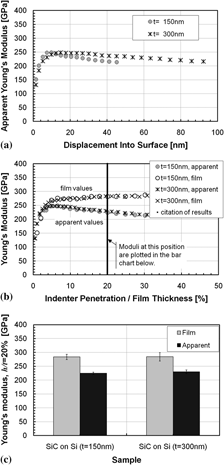Crossref Citations
This article has been cited by the following publications. This list is generated based on data provided by
Crossref.
Kim, Yi-Yeoun
Ganesan, Kathirvel
Yang, Pengcheng
Kulak, Alexander N.
Borukhin, Shirly
Pechook, Sasha
Ribeiro, Luis
Kröger, Roland
Eichhorn, Stephen J.
Armes, Steven P.
Pokroy, Boaz
and
Meldrum, Fiona C.
2011.
An artificial biomineral formed by incorporation of copolymer micelles in calcite crystals.
Nature Materials,
Vol. 10,
Issue. 11,
p.
890.
Dafinone, Majemite I.
Feng, Gang
Brugarolas, Teresa
Tettey, Kwadwo E.
and
Lee, Daeyeon
2011.
Mechanical Reinforcement of Nanoparticle Thin Films Using Atomic Layer Deposition.
ACS Nano,
Vol. 5,
Issue. 6,
p.
5078.
Hay, Jennifer
2011.
MEMS and Nanotechnology, Volume 4.
p.
45.
Zhang, Lei
Prosser, Jacob H.
Feng, Gang
and
Lee, Daeyeon
2012.
Mechanical properties of atomic layer deposition-reinforced nanoparticle thin films.
Nanoscale,
Vol. 4,
Issue. 20,
p.
6543.
Botero, C.A.
Jiménez-Piqué, E.
Baudín, C.
Salán, N.
and
Llanes, L.
2012.
Nanoindentation of Al2O3/Al2TiO5 composites: Small-scale mechanical properties of Al2TiO5 as reinforcement phase.
Journal of the European Ceramic Society,
Vol. 32,
Issue. 14,
p.
3723.
Botero, C.A.
Jimenez-Piqué, E.
Seuba, J.
Kulkarni, T.
Sarin, V.K.
and
Llanes, L.
2012.
Mechanical behavior of 3Al2O3·2SiO2 films under nanoindentation.
Acta Materialia,
Vol. 60,
Issue. 16,
p.
5889.
Fasce, L.A.
Seltzer, R.
and
Frontini, P.M.
2012.
Depth sensing indentation of organic–inorganic hybrid coatings deposited onto a polymeric substrate.
Surface and Coatings Technology,
Vol. 210,
Issue. ,
p.
62.
Wu, Xiaoxia
and
Xu, Terry T.
2012.
Measurement of mechanical properties of alkaline-earth metal hexaboride one-dimensional nanostructures by nanoindentation.
Journal of Materials Research,
Vol. 27,
Issue. 9,
p.
1218.
Cohen, Sidney R
and
Kalfon-Cohen, Estelle
2013.
Dynamic nanoindentation by instrumented nanoindentation and force microscopy: a comparative review.
Beilstein Journal of Nanotechnology,
Vol. 4,
Issue. ,
p.
815.
Giró-Paloma, J.
Roa, J.J.
Díez-Pascual, A.M.
Rayón, E.
Flores, A.
Martínez, M.
Chimenos, J.M.
and
Fernández, A.I.
2013.
Depth-sensing indentation applied to polymers: A comparison between standard methods of analysis in relation to the nature of the materials.
European Polymer Journal,
Vol. 49,
Issue. 12,
p.
4047.
Hemmouche, L.
Chicot, D.
Amrouche, A.
Iost, A.
Belouchrani, M.A.
Decoopman, X.
Louis, G.
and
Puchi-Cabrera, E.S.
2013.
An analysis of the elastic properties of a porous aluminium oxide film by means of indentation techniques.
Materials Science and Engineering: A,
Vol. 585,
Issue. ,
p.
155.
Zhang, Chunyu
Zhao, Meng
Liu, Yulan
and
Wang, Biao
2013.
Extracting the elastic moduli of the constituent layers of a multilayered thin film from nanoindentation tests.
Journal of Materials Research,
Vol. 28,
Issue. 18,
p.
2570.
Zhang, Lei
Feng, Gang
Zeravcic, Zorana
Brugarolas, Teresa
Liu, Andrea J.
and
Lee, Daeyeon
2013.
Using Shape Anisotropy to Toughen Disordered Nanoparticle Assemblies.
ACS Nano,
Vol. 7,
Issue. 9,
p.
8043.
Gotlib-Vainshtein, Katya
Girshevitz, Olga
Sukenik, Chaim N.
Barlam, David
Kalfon-Cohen, Estelle
and
Cohen, Sidney R.
2013.
Oxide Surfaces with Tunable Stiffness.
The Journal of Physical Chemistry C,
Vol. 117,
Issue. 43,
p.
22232.
Elgazzar, Haytham A
Salem, Hanadi G
Mattar, Taha M
Hassan, Ali M
and
Abdel-Rahman, Ehab
2013.
Characterization of structures and properties of amorphous nanostructured SiC thin films deposited on AISI 304 stainless steel using pulsed laser deposition.
Proceedings of the Institution of Mechanical Engineers, Part N: Journal of Nanoengineering and Nanosystems,
Vol. 227,
Issue. 4,
p.
199.
Schwieker, Kevin
Frye, James
and
Prorok, Barton C.
2013.
MEMS and Nanotechnology, Volume 6.
p.
41.
Mamun, M.A.
Stegall, D.E.
Korwin‐Pawlowski, M.L.
and
Elmustafa, A.A.
2013.
TMS2013 Supplemental Proceedings.
p.
555.
Cheng, Yong
Wang, Shu Yun
Lu, Yi Min
Huang, Guo Jun
Guo, Yan Long
Liu, Xu
and
Sun, Bin
2014.
Research of Diamond-Like Carbon Film Deposited by Double Pulsed Lasers.
Vol. 95,
Issue. ,
p.
11.
Liu, Xuwen
Haimi, Eero
Hannula, Simo-Pekka
Ylivaara, Oili M. E.
and
Puurunen, Riikka L.
2014.
On the reliability of nanoindentation hardness of Al2O3 films grown on Si-wafer by atomic layer deposition.
Journal of Vacuum Science & Technology A: Vacuum, Surfaces, and Films,
Vol. 32,
Issue. 1,
Jiménez-Piqué, E.
González-García, L.
Rico, V.J.
and
González-Elipe, A.R.
2014.
Nanoindentation of nanocolumnar TiO2 thin films with single and stacked zig-zag layers.
Thin Solid Films,
Vol. 550,
Issue. ,
p.
444.
